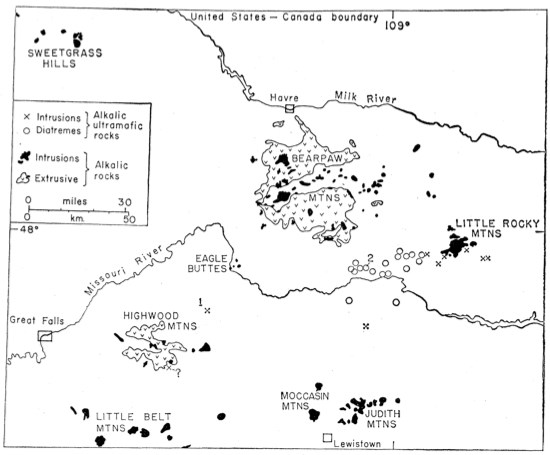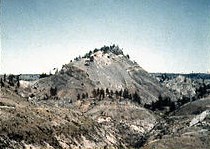For more information on floating the river and the first EarthCache in this series, please see this link.
For the next EarthCache in the trail, click here.
-------------------------------
Diatremes in the Breaks
This EarthCache begins at Gist Bottom, a campsite at river mile 122.6. From the campsite, follow a dirt road for a ways before eventually veering off to the northwest (straight/left) to continue towards the given coordinates. Walk slowly and keep an eye (and ear) out for rattlesnakes, as well as prickly pear cacti. At some point you should encounter a drainage, which will lead you to the coordinates at the side of a sandstone bluff.
Once at the coordinates, turn to your left (west) and you should see a giant mound of dark-colored rock. This massive outcrop is called a diatreme. A diatreme is a column of volcanic material formed by a violent, gaseous eruption that came from deep in the Earth’s crust. Diatremes are rare volcanic features that form from gas-rich magma. As the magma rises through the crust, it reaches a point when the gas pressure in the magma exceeds the confining pressure (weight) of the overlying rocks. The gas expands forcefully, shattering the overlying material and blasting it into the air along with globs of magma.
Diatremes often contain xenoliths, which are bits of local rock that become incorporated into volcanic rock during an eruption. For example, a chunk of sandstone in a volcanic dike is a xenolith. An abundance of xenoliths is a clue to geologists that an outcrop may be a diatreme. The diatreme at this site is one of the many diatremes in the region, which are concentrated in a west-east band running from the Stafford Ferry to the Little Rocky Mountains.
 Diatremes, hollow circles on the map, are concentrated to the west of the Little Rocky Mountains
Source: Carter, Hearn, Diatremes with Kimberlitic Affinites in North-Central Montana, 1968
Diatremes, hollow circles on the map, are concentrated to the west of the Little Rocky Mountains
Source: Carter, Hearn, Diatremes with Kimberlitic Affinites in North-Central Montana, 1968
Diatremes are similar to volcanic plugs, which are also pipe-like vents of material that has solidified from magma. However, volcanic plugs are intrusive, forming from magma that cooled slowly under the surface (other intrusive bodies include dikes, sills, and plutons). In contrast, diatremes are extrusive, forming from erupted magma that cooled almost immediately upon being exposed to the relatively cool temperatures at or near the surface. Examples of other extrusive rocks are lava, obsidian, scoria, and any fragments or particles ejected by eruptions, generally termed tephra or pyroclastics.
 Extrusive vs. intrusive igneous rocks in a generalized volcanic environment. Note the xenolith incorporated into the igneous rock at bottom right!
Source: Ana Rita Rainho, http://biogeolearning.com/web/index.php/en/igneous-rocks.html
Extrusive vs. intrusive igneous rocks in a generalized volcanic environment. Note the xenolith incorporated into the igneous rock at bottom right!
Source: Ana Rita Rainho, http://biogeolearning.com/web/index.php/en/igneous-rocks.html
Diatremes and plugs also differ in shape. Volcanic plugs are generally uniform in width, like a cylinder, while diatremes converge downward like a steep-walled funnel in the shape of a carrot. The tops of diatremes are rarely preserved because of erosion. Instead, the typical perspective is a horizontal cross-section of the vent. The dark mound visible at this site is the eroded remnants of the diatreme pipe.
 Basic cross-section of a diatreme
Source: Virginia Department of Mines, Minerals, and Energy, Eocene Igneous Rocks Near Monterey, VA: A Field Study, 2006
Basic cross-section of a diatreme
Source: Virginia Department of Mines, Minerals, and Energy, Eocene Igneous Rocks Near Monterey, VA: A Field Study, 2006
Volcanic plugs stand out as solid masses of igneous rock, since they are more resistant to erosion than the surrounding rock. Diatremes, on the other hand, are more subdued on the landscape, and sometimes even vegetated. This is because they are composed of loose piles of a rock called volcanic breccia, an unsorted mix of volcanic rock ranging from large angular blocks to fine ash. Volcanic breccia forms when rocks are blasted apart by violent eruptions, such as those that create a diatreme. Globs of magma may flash-cool to solid volcanic blocks, while finer particles turn to volcanic ash. Some of the pyroclastic material from the eruption then falls back into and fills the pipe; as it settles, distinct bedding can develop. This loose volcanic breccia that fills the vent is the diatreme rock that we see today.
 Black Butte diatreme in the Missouri Breaks. The tall mound in this photo is the eroded remnant of its volcanic pipe. The same mound is represented by the “present surface line” in the cross-section graphic below.
Source: Fine Art America, by Granger, http://fineartamerica.com/featured/diatreme-diagram-granger.html
Black Butte diatreme in the Missouri Breaks. The tall mound in this photo is the eroded remnant of its volcanic pipe. The same mound is represented by the “present surface line” in the cross-section graphic below.
Source: Fine Art America, by Granger, http://fineartamerica.com/featured/diatreme-diagram-granger.html
Immediately following an eruption, fresh volcanic breccia in a diatreme contains a lot of uncompressed ash. Overtime, these unconsolidated deposits are compacted by the weight of overlying volcanic material. This causes subsidence of blocks within the vent, which lead to the formation of a ring of normal faults around the sides of the pipe (for more information on faults, see the next EarthCache). Studies on diatremes have revealed down-faulted blocks of sedimentary formations far below where they are normally found, indicating that diatreme vent fill can subside thousands of vertical feet!
 A detailed cross-section of a diatreme, based on the Black Butte diatreme in the Upper Missouri Breaks National Monument. The “present surface” line indicates the extent to which the Black Butte diatreme has been eroded to date. Note the down-faulted blocks along the sides, the bedded volcanic breccia throughout, and the columns of solid igneous rocks in the center, which indicate subsequent eruptions. As you can see from the scale on the bottom left, diatremes can be quite extensive. Source: Hearn Carter, Diatremes with Kimberlitic Afinites in North-Central Montana, 1968.
A detailed cross-section of a diatreme, based on the Black Butte diatreme in the Upper Missouri Breaks National Monument. The “present surface” line indicates the extent to which the Black Butte diatreme has been eroded to date. Note the down-faulted blocks along the sides, the bedded volcanic breccia throughout, and the columns of solid igneous rocks in the center, which indicate subsequent eruptions. As you can see from the scale on the bottom left, diatremes can be quite extensive. Source: Hearn Carter, Diatremes with Kimberlitic Afinites in North-Central Montana, 1968.
Diatremes are important because they provide an opportunity to study rocks from great depth that would otherwise be inaccessible. The composition of diatremes reflects their deep-rooted origins: diatremes usually consist of potassium- and magnesium-rich rocks, such as lamproite or kimberlite, and also feature many olivine mineral crystals. These elements and minerals are rarely found at the surface, but are common in mantle rocks. Kimberlite pipes are of great economic value because they often contain diamonds. In fact, kimberlite diatremes are the most important source of mined diamonds today. However, the diatremes here in the Missouri Breaks have been studied extensively and do NOT contain diamonds. Please do not try prospecting for diamonds at the expense of damaging this magnificent geology structure!
NOTE If you are thinking of walking up to the diatreme for a closer look, please consider that it is a half-mile walk through unforgiving terrain, with no trail and many cacti. Snakes and other reptiles are also attracted to the diatreme’s dark rock, which is hot because it draws in more sunlight.
To claim this cache: Answer the following questions and send the answers using Geocache's messaging tool.
Q. Describe the appearance of the diatreme at this site in as much detail as possible from a distance. Try and touch on characteristics of geological importance, such as the size of the feature, color, whether bedding is visible, and what you think the rock type could be.
Q. Does the diatreme at this site appear to have a crater? Why do you think that might be the case?